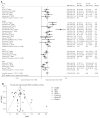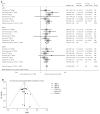The Increased Level of Depression and Anxiety in Irritable Bowel Syndrome Patients Compared with Healthy Controls: Systematic Review and Meta-analysis
- PMID: 28672433
- PMCID: PMC5503284
- DOI: 10.5056/jnm16220
The Increased Level of Depression and Anxiety in Irritable Bowel Syndrome Patients Compared with Healthy Controls: Systematic Review and Meta-analysis
Abstract
Background/aims: Irritable bowel syndrome (IBS) patients commonly experience psychiatric disorders, such as depression and anxiety. This meta-analysis sought to compare depression and anxiety levels between IBS patients and healthy controls.
Methods: We searched major electronic databases (PubMed, EMBASE, MEDLINE, and Cochrane library) to find comparative studies on IBS patients and healthy controls. The primary outcome was a standardized mean difference (SMD) of anxiety and depression levels; sub-group analyses were conducted according to IBS-subtypes.
Results: In total, 2293 IBS patients and 4951 healthy controls from 27 studies were included. In random effect analysis, depression and anxiety levels were significantly higher in IBS patients (pooled SMD = 0.76; 95% CI, 0.62-0.90; P < 0.001; I2 = 77.2% and pooled SMD = 0.84; 95% CI, 0.67-1.01; P < 0.001; I2 = 85.6%, respectively). Both analyses' funnel plots showed symmetry. In meta-regression analysis, heterogeneity was due to the studied region and questionnaire type for both depression and anxiety. In sub-group analyses of IBS-subtype, the pooled SMDs of depression and anxiety levels (IBS with predominant constipation: 0.83 and 0.81, IBS with predominant diarrhea: 0.73 and 0.65, and IBS with mixed bowel habits: 0.62 and 0.75; P < 0.001, respectively) were significantly higher in all IBS-subtypes.
Conclusions: The present meta-analysis showed depression and anxiety levels to be higher in IBS patients than in healthy controls, regardless of IBS-subtype. However, the gender effect on psychological factors among IBS patients could not be determined and should be evaluated in prospective studies.
Keywords: Anxiety; Depression; Irritable bowel syndrome; Meta-analysis.
Conflict of interest statement
Figures





Similar articles
-
The level and prevalence of depression and anxiety among patients with different subtypes of irritable bowel syndrome: a network meta-analysis.BMC Gastroenterol. 2021 Jan 7;21(1):23. doi: 10.1186/s12876-020-01593-5. BMC Gastroenterol. 2021. PMID: 33413140 Free PMC article.
-
Gut Microbial Dysbiosis in the Irritable Bowel Syndrome: A Systematic Review and Meta-Analysis of Case-Control Studies.J Acad Nutr Diet. 2020 Apr;120(4):565-586. doi: 10.1016/j.jand.2019.05.015. Epub 2019 Aug 28. J Acad Nutr Diet. 2020. PMID: 31473156
-
Comparison of comorbid depression between irritable bowel syndrome and inflammatory bowel disease: A meta-analysis of comparative studies.J Affect Disord. 2018 Sep;237:37-46. doi: 10.1016/j.jad.2018.04.111. Epub 2018 May 4. J Affect Disord. 2018. PMID: 29758449
-
Anxiety and depression in Indian patients with irritable bowel syndrome: A meta-analysis.Indian J Gastroenterol. 2023 Feb;42(1):32-39. doi: 10.1007/s12664-022-01300-0. Epub 2023 Jan 19. Indian J Gastroenterol. 2023. PMID: 36656484
-
Effect of Acupuncture on Anxiety, Depression, and Quality of Life in Patients with Irritable Bowel Syndrome: A Meta-Analysis.Int J Behav Med. 2025 Jan 27. doi: 10.1007/s12529-025-10348-z. Online ahead of print. Int J Behav Med. 2025. PMID: 39870963 Review.
Cited by
-
Gastric symptoms and low perceived maternal warmth are associated with eating disorder symptoms in young adolescent girls.Int J Eat Disord. 2021 Jun;54(6):1009-1018. doi: 10.1002/eat.23516. Epub 2021 Apr 9. Int J Eat Disord. 2021. PMID: 33836108 Free PMC article.
-
Two Gold Kiwifruit Daily for Effective Treatment of Constipation in Adults-A Randomized Clinical Trial.Nutrients. 2022 Oct 6;14(19):4146. doi: 10.3390/nu14194146. Nutrients. 2022. PMID: 36235798 Free PMC article. Clinical Trial.
-
Antibiotics, gut microbiota, and irritable bowel syndrome: What are the relations?World J Gastroenterol. 2022 Mar 28;28(12):1204-1219. doi: 10.3748/wjg.v28.i12.1204. World J Gastroenterol. 2022. PMID: 35431513 Free PMC article. Review.
-
Guidelines on the management of irritable bowel syndrome: In memory of Professor Witold Bartnik.Prz Gastroenterol. 2018;13(4):259-288. doi: 10.5114/pg.2018.78343. Epub 2018 Sep 19. Prz Gastroenterol. 2018. PMID: 30581501 Free PMC article.
-
A Narrative Review of Irritable Bowel Syndrome with Diarrhea: A Primer for Primary Care Providers.Adv Ther. 2022 Sep;39(9):4003-4020. doi: 10.1007/s12325-022-02224-z. Epub 2022 Jul 22. Adv Ther. 2022. PMID: 35869354 Free PMC article. Review.
References
-
- Mearin F, Mearin F, Chang L, et al. Bowel disorders. Gastroenterology. 2016;150:1393–1407. e1395. doi: 10.1053/j.gastro.2016.02.031. - DOI
-
- Van Oudenhove L, Crowell MD, Drossman DA, et al. Biopsychosocial aspects of functional gastrointestinal disorders: how central and environmental processes contribute to the development and expression of functional gastrointestinal disorders. Gastroenterology. 2016;150:1355–1367. e2. doi: 10.1053/j.gastro.2016.02.027. - DOI - PMC - PubMed
Publication types
LinkOut - more resources
Full Text Sources
Other Literature Sources

